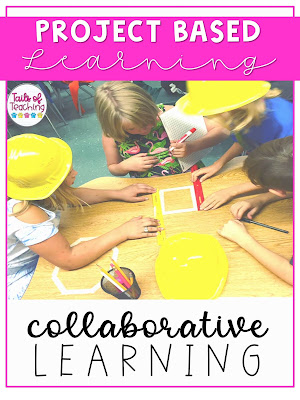Close your eyes (yes
really do it) and imagine an ordinary classroom. When you open the classroom
door, you take a double look. What is happening in this room? Students are
totally engaged; working on computers, posters, and taking charge. Where is the
teacher? Their teacher is coaching students and pushing their thinking. This
is a fake example right? Nope, this is what a classroom looks like when
students dive into a Project Based Learning Unit. What is Project Based
Learning? Why is Project Based Learning important? How could I possibly fit in
one more thing when my day is already so jam-packed? I want to tell you
that Project Based Learning is not only the bom-dot-com, but the thing that
single-handedly reignited my flame for teaching. Read this post to learn what
Project Based Learning is, and why it saves time and my teacher sanity.
What is Project Based Learning?
PBL Works says that,
“Project Based Learning (PBL) is a teaching method in which students learn by
actively engaging in real-world and personally meaningful projects.” Project
Based Learning is an instructional style that is inquiry based and student
lead. Project based learning allows students to hop in the driver's seat, while
the teacher takes the co-pilot role. Throughout a Project Based Learning unit,
students will use driving questions to research, collaborate, and produce a way
to show their learning.
How to Get Started with Project Based Learning
Ready to ramp up the
student engagement in your classroom? Try out Project Based Learning.
Benefits: increased
instructional time, increased student engagement, giving students the
opportunity to take charge of their own learning, and more. Sounds pretty sweet
doesn’t it? But the real question is how the heck do I fit an extra thing into
my day? There is not enough time as it is, how could I possibly add in
something else? I know it sounds odd, but when you implement P.B.L. units,
you actually save instructional time.
Project Based Learning Step 1: align your units across subject areas
One of the best ways to
get the most bang for your buck out of a Project Based Learning Unit is to
teach it in an interdisciplinary style. This means rearranging your units
(across all subject areas) so they align in the most cohesive way. For example,
if you normally teach animal traits for science in October and informational
writing in February, switch it around so you teach these units at the same
time. Why? It is more cohesive for students and it saves you instructional
time. Now you are totally focused on researching, learning, and writing about
animal traits. This saves you time across subject areas and allows you to dive
deeper into projects and higher order thinking skills you otherwise wouldn’t
have time for. Go get a scrap piece of paper and write out all your units for
the year in the order you typically teach them. Can you rearrange any for
better pairings? Are there any common themes jumping out at you? You might have
the start to a great Project Based Learning Unit on your hands!
Project Based Learning Step 2: write driving questions
Now that your units are
aligned, you need to start planning. Step one is to find your driving question.
I like to think of this as your non-Google-able question. For example in my
Will You Survive the Island? project based learning unit, my driving question
says, “is survival possible on a deserted island?” This is a question that cannot
be answered with a quick 2 second Google search. This is a meaty question that
my students will have to research and prove through the course of our P.B.L. unit.
Project Based Learning Step 3: student voice and choice
Now that you’ve asked the big question, how will your
students demonstrate their knowledge throughout the course of the project based
learning unit? In my project based learning units, I give my kiddos a
presentation menu. This allows my students to choose how they will share their
new learning and discoveries with the class. Some options I like to use
include a poster, speech, multimedia project, demonstration, and more. Whatever
your options are, the key is just to allow students with voice and choice.
(Make sure they have clear expectations for each option).
Project Based Learning Step 4: inquiry based
learning
This step is probably the most difficult for teachers. In this step
we must take the role of a coach instead of the sole instructor. Help your
kiddos by asking probing questions that lead their inquiry and learning. You
are not the sole provider of answers, but instead the guiding force as they
research and solve for themselves.
Project Based Learning Step 5: public presentation
This step is such an important one. The final step in a project
based learning unit is presentation. This step promotes students to take
accountability and pride in their learning. Students will work on a
presentation method of their choice throughout this project based learning unit
and then present it to an audience. The more meaningful the audience the more
effort students will put into their projects, and the more pride they will
feel. For example, if your students are studying the best way to promote
community involvement and they present to a town selectman, it makes the
project feel so real and meaningful.
Now that you know the
steps, I hope you take the jump and try a project based learning unit in you
classroom this year!
Want to get started with
Project Based Learning now? Check out my Project Based Learning Growing Bundle
HERE!





















No comments:
Post a Comment